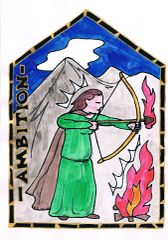Ambition
The Path of Ambition
A general commands an army of thousands. An archmage wields eldritch power. The Throne controls the destiny of the Empire. Had they lacked Ambition, they would be nothing.
Ambition is the call to action, the urge to self-fulfillment, and the burning need to make a mark on the world before passing back into the Labyrinth. Ambition is a basic human drive, and for a Citizen to try to defy its call is not only heretical – it is inhuman. It is easy to wish for something, to want the world to be different; Ambition is the tool that spurs humans on to make their dreams tangible, to enact the change they desire, to shape themselves and the world around them to match their imagination.
In traditional theology, Ambition is the combination of two basic urges. The first is the struggle for self-actualisation - the desire to achieve one's full potential through creativity, independence, spontaneity, and a grasp of the real world. The other is the urge to compete with others, often to prove one's superiority or to secure wealth, position or authority. The early Synod debated at length over whether these urges were best represented by the term “Ambition” or “Aspiration”; the latter was ultimately considered too inactive in character - too passive and too reminiscent of Ambition’s dark mirror, the False Virtue of Hope. The name is not banned; it is just a little heterodox, and persists in song and sermon.
Many priests regard the competitive element as the more important of the two. Though many Citizens associate the Virtue of Ambition with an eye on a Senator’s seat or even the Imperial Throne, this Path embraces many subtler expressions also. The artisan who strives to create something truly new, the merchant who strives for dominance in his city or his industry, the youth who longs after forbidden love – the competitive instinct, Ambition, is ultimately what drives them to their goal.
As with most Virtues, the trick is to keep going. Ambition, like Loyalty, demands unwavering dedication. The artisan who strives to make something new and distinctive must constantly study and practice, and must be ready to face imitation and hardship without giving up her dream. The merchant who strives for dominance must be prepared to offer the best, always and without falter, and to take on and defeat the efforts of his opponents. The youth who longs after forbidden love – well, perhaps she must be prepared to give up everything to flee with her paramour. The cost of Ambition can be as high as the deadly cost of Courage and as torturous as the long fate of Loyalty, and just like these other Virtues, Ambition demands dedication.
Power is seen as a worthy goal by those who are Ambitious, but power for it's own sake is merely an ornament. The ultimate expression of Ambition is often seen as being the exercise of power to leave a lasting mark on the world and the souls of other people. The Ambitious never rest on their laurels; having achieved their goal, and having enjoyed their success for a time, they should always then find a new goal for themselves.
Guidance on the Path
Through study of the Paragons and Exemplars, the priests of The Way have gleaned insight into the heart of the Virtue and how best to pursue it. There are collections of parables, tales, sayings and teachings that distill this for Imperial Citizens to learn from. The following are a handful of teachings and sayings deemed to be essential to understanding the Path:
- Aim high; pursue your dreams; nothing is beyond your grasp.
- Even the most impenetrable forest may fall one tree at a time.
- Consequences are the price of Ambition; no price is too high to realise your dreams.
- It is better, by far, to try and fail, than fail to try.
- Despise the weakness that comes from pettiness and lack of vision.
Paragons and Exemplars
Recognised Paragons and Exemplars of Ambition include:
- The Paragon Tian. Tian is the oldest recorded Paragon of Ambition who, so legend has it, overcame many challenges and foes to ascend the highest mountain in all creation to steal fire from the sun and bring it to her people – and all humankind. The act of carrying fire caused her hands to be forever burned, but her ambition ensured that her people never went cold again.
- The Paragon Aldones di Sarvos, one of the founders of the League.
- The Exemplar Atuman of the Highborn, who lead his people to the shores of Highguard.
- The Exemplar Adelmar the Lion, founder of the School of Arms and an inspiration to weapon masters throughout the Empire.
Symbols, icons and trappings
The Path of Ambition has many symbols and icons across the Empire, but one of the most common and prevalent is Flame. This is not only symbolic of Tian’s quest to steal the fire of the sun, but fire possesses many of the qualities of purest ambition. It is ever hungry and never satisfied, for the moment it is satisfied, it dies. Some Pilgrims of Ambition even go as far as to burn a brand on their arm or hand in recognition of the price Tian paid or as a reminder of how dangerous Ambition can be.
More mystically inclined individuals point to the rune Naeve, which represents hunger, as a symbol of Ambition.
Further Reading
- You can learn about the various spiritual roleplaying effects created by priests dedicated to Ambition here.
- You can learn about the skills that priests can use to spread the virtue of Ambition here.
